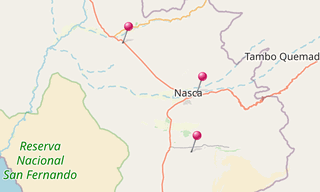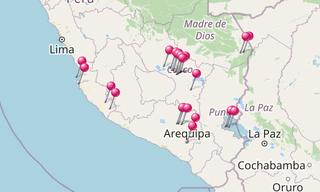The Nazca lines are a series of geoglyphs located in the Nazca Desert that stretches over more than 80 km and have been created by the Nazca culture between 200 BC and AD 700. There are hundreds of stylised figures (hummingbirds, spiders, monkeys, fish, sharks or orcas, lamas, and lizards). The Nazca have also built an impressive system of underground aqueducts still in function today.
Necropolis of Chauchilla
Chauchilla Cemetery is a cemetery that contains prehispanic mummified human remains and archeological artifacts, located 30 km from the city of Nazca in Peru. The cemetery was discovered in the 1920s, but had not been used since the 9th century AD.
The cemetery includes many important burials over a period of 600 to 700 years. The start of the interments was in about 200 AD. It is important as a source of archaeology to Nazca culture. The cemetery has been extensively plundered by huaqueros (grave robbers) who have left human bones and pottery scattered around the area.
The bodies are so remarkably preserved due mainly to the dry climate in the Peruvian Desert but the funeral rites were also a contributing factor. The bodies were clothed in embroidered cotton and then painted with a resin and kept in purpose-built tombs made from mud bricks.
The resin is thought to have kept out insects and slowed bacteria trying to feed on the bodies.
Nazca Lines
The Nazca Lines are a group of very large geoglyphs made in the soil of the Nazca Desert in southern Peru. They were created between 500 BC and 500 AD by people making depressions or shallow incisions in the desert floor, removing pebbles and leaving differently colored dirt exposed. In the years leading up to 2020, between 80 and 100 new figures had been found with the use of drones, and archaeologists believe that there are more to be found.
Most lines run straight across the landscape, but there are also figurative designs of animals and plants. The individual figurative geoglyph designs measure between 0.4 and 1.1 km across. The combined length of all the lines is over 1,300 km, and the group covers an area of about 50 km².
The lines are typically 10 to 15 cm deep. They were made by removing the top layer of reddish-brown iron oxide-coated pebbles to reveal a yellow-grey subsoil. The width of the lines varies considerably. In some places they may be only 30 cm wide, and in others reach 1.8 m wide.
The shapes are usually made from one continuous line. The largest ones are about 370 m long. Because of its isolation and the dry, windless, stable climate of the plateau, the lines have mostly been preserved naturally. The figures vary in complexity. Hundreds are simple lines and geometric shapes; more than 70 are zoomorphic designs, including a hummingbird, spider, fish, condor, heron, monkey, lizard, dog, cat, and a human. Other shapes include trees and flowers.
Cantalloc Aqueducts (Puquios)
The Cantalloc Aqueducts are a series of aqueducts located 4 km west of the city of Nazca, Peru, built by the Nazca culture. More than 40 aqueducts were built, which were used all year round. There are other aqueducts in different parts of the city. They are part of a system of aqueducts of the same type called puquios that were built by the pre-Inca civilization of Nazca about 1,500 years ago.
The aqueducts ensured the supply of water to the city of Nazca and the surrounding fields, allowing the cultivation of cotton, beans, potatoes, and other crops in an arid region. The coasts of Peru and Chile are exceptionally arid with agriculture only possible with irrigation.
Two types of puquios are in the Nazca region. The first is the trench puquios which is a deep, narrow ditch, usually less than one meter in width and lined with rocks, which is open to the air. The second type is the gallery or subterranean puquios which is tunneled beneath the earth to tap the water from an aquifer.
Cahuachi
Cahuachi, in Peru, was a major ceremonial center of the Nazca culture, based from 1 AD to about 500 AD in the coastal area of the Central Andes. It overlooked some of the Nazca lines. The Italian archaeologist Giuseppe Orefici has been excavating at the site for the past few decades. The site contains over 40 mounds topped with adobe structures. The huge architectural complex covers 1.5 km² at 365 m above sea level.

.hero.landscape.jpg?w=1600)


.jpg?w=256)
.jpg?w=256)
.jpg?w=256)
-Pisco-Wine-Amphorae.jpg?w=256)
.jpg?w=256)
-Puquios.jpg?w=256)
-Puquios.jpg?w=256)
.jpg?w=256)
.jpg?w=256)
.jpg?w=256)
-Geoglyph-Las-Manos.jpg?w=256)
.jpg?w=256)
-Cahuachi.jpg?w=256)
.jpg?w=256)
.jpg?w=256)
.jpg?w=256)
.jpg?w=256)
.jpg?w=256)
.jpg?w=256)
-Pisco-Wine-Amphorae.jpg?w=256)
-Pisco-Wine-Amphorae.jpg?w=256)
.jpg?w=256)
.hero.jpg?w=320)

.hero.jpg?w=320)
.map.png)